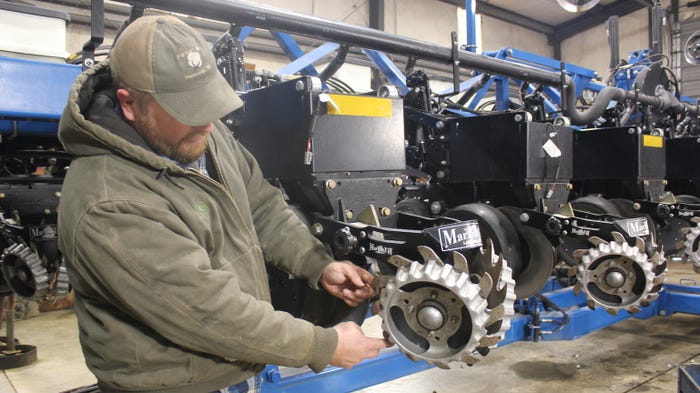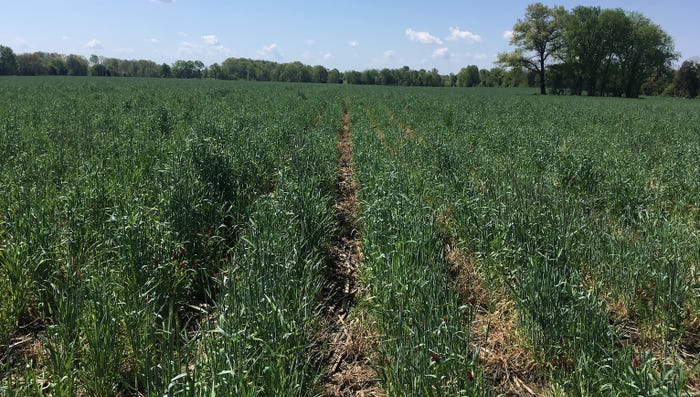
Tennessee farmer Matt Griggs first experimented with planting green six years ago.Ginger Rowsey
If you spoke to 10 different people about cover crops, you may very likely get 10 different opinions. From species to plant to how to get them in the ground, farmers have formed vastly different conclusions.
However, termination timing may be the aspect of cover crop production where the most questions remain. Terminating too early could make fields vulnerable to weed pressure. Terminating too late could be detrimental to the cash crop, not to mention issues with dense residue at planting.
While planting into live cover may be the riskiest option as far as cover crop termination timing goes, Matt Griggs, a fifth-generation farmer near Humboldt, Tenn., has found success with planting green. During the virtual Cotton and Rice Conference on Feb. 10, he shared his trial-and-error experiences and how he’s learned to make it work.
Planting green
Griggs has been one of his state’s earliest proponents of cover crops. Driven to experiment after the devastating drought of 2007 and the onslaught of glyphosate-resistant weeds in the years that followed, Griggs first tried planting into live cover in 2015.
“The first year I planted green, I pulled into the first field and after about 50 feet, everything on my planter was locked up. It was a disaster,” Griggs said. “It took us about 10 days to plant 500 acres of cotton.”
“We did get a stand that year, but it was a nightmare planting experience,” Griggs continued. “We quickly realized that we couldn’t plant cotton in this level of biomass without making some changes.”
Those changes started with modifying the row cleaners on his planter — brought about by some farm resourcefulness.
“We had some old disc openers on the scrap iron pile. We took a plasma cutter, cut them down to the right diameter and bolted them on the backside of the row cleaner to make a solid wheel so the teeth couldn’t grab the cover crop and lock up,” Griggs explained. “We used those for several years and they worked well.”

Since then, Griggs has purchased a new planter and has added Martin-Till Razor Wheels to his row units. He says he’s pleased with their ability to cut through residue, although he says they’re not as aggressive as his homemade prototype.
Another change he’s made is planting his cotton one-half inch deeper than he did before.
“If you think about the design of the disc opener, the shallower you plant, the narrower the trench gets, whereas the deeper you plant the wider the trench gets,” Griggs said. “With a wider trench there’s less chance of the cover crop interfering with the placement of the seed.”
“We traditionally plant cotton as shallow as possible, but when planting into a high level of biomass, you don’t have to worry about a packing rain causing the ground to crust over and prevent emergence. This ground is going to be as mellow as it can be. It’s more important to be sure we get the seed in the ground.”
Strip kill
For Griggs, the practice that has probably most impacted his success with planting into live cover is strip killing. The concept is similar to strip tillage, but instead of breaking up a narrow strip of ground, Griggs is spraying herbicide over an 8 – 10-inch band into which he’ll later plant.
“I’ve been blown away by how well strip kill has worked for us,” Griggs said. “We get all the benefits of high biomass cover crops, but it’s just as easy as planting into no-till.
To make it work, Griggs says he modified a hooded sprayer by placing drop nozzles that spray between the hoods. He typically makes an application of glyphosate around mid-March. As all his guidance lines are logged using RTK, Griggs insists planting back into the strips is as easy as swapping out the memory card from the sprayer to the planter.
“It’s an extra pass across the field, and it’s not really quick to run a hooded sprayer, but we’ve done it for three years now and ever since we’ve had picture perfect cotton stands,” Griggs said. “There have been no problems with anything wrapping up on the planter. It’s just worked really great.”

Griggs uses strip kill on all of his cotton. University of Tennessee Extension Cotton Specialist Tyson Raper discussed Griggs’ method at the Milan No-Till Field Day — saying while it may not be for every operation, it could be a means to address challenges from both early termination and at planting termination.
“By stripping the biomass out of the furrow, you may see some weed issues right in the furrow, but you get suppression in the middles,” Raper said. “It seems like a great way to keep biomass in the system while minimizing the risks, specifically risks associated with planter attachments, so I see a lot of potential.
Getting cover crop down
Six to eight weeks after killing the strips, Griggs begins his termination protocol. First an application of paraquat, followed by a pass with the roller crimper a few hours later. Then he’s ready to plant. Griggs says getting the cover crop on the ground is a key to success.
“We rely heavily on the roller crimper in our operation,” said Griggs. “Once your cover crop is terminated, whatever is still standing is not benefitting you that much. It’s very important to get the cover crop on the ground.”
Griggs uses a custom 20-foot roller crimper manufactured by I & J. Paired with his strip kill method, the roller crimper maximizes the mulching effects and barrier of cover crops in the middles, while decreasing interference with newly planted cotton.
“A roller crimper is not a silver bullet. It works really well on mature grasses (in the milk stage) and legumes like hairy vetch. It doesn’t work as well on annual ryegrass. We’ll still need burndown herbicides, but we can reduce our rates.”
Wait for right conditions
Griggs’ last piece of advice for producers wanting to plant green is to be patient. Wait for the right conditions — especially if you’re just getting started with cover crops.
“Dense cover crops will magnify poor weather conditions,” Griggs said. “If it’s cool in no-till ground, it’s going to be cooler in cover crops. If you’ve got saturated no-till ground, once you kill that cover crop your ground will be even more saturated. Once you’ve had cover crops for a while, those factors, especially drainage, will not be as bad.”
He says when planting cotton into heavy biomass, it can take 3-5 days to get a stand. If weather turns bad, replanting is a real possibility.
“Just because you see your neighbors going to the field with their planters doesn’t mean you need to be going to the field with your planter. That was a hard lesson for me.”
About the Author(s)
You May Also Like






